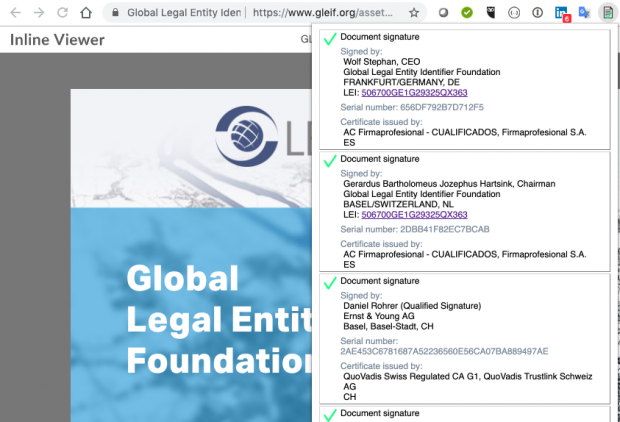GLEIF Leaps into the Digital Future with LEI Digital Certificates and Inline XBRL

This week the Global Legal Entity Identifier Foundation (GLEIF) took a small technical step that in many ways represents a giant leap forward for global trust.
Its 2018 Annual Report was published and is the first Inline XBRL document (indeed, any kind of document) to include a new type of digital signature that embeds the organisation’s LEI within it. This provides a permanent digital connection between the document and the organisation that published it. As an eIDAS certificate, the digitally signed document is legally recognised. Equally, the LEI, by its very nature, is a neutral, globally recognised identifier. By embedding the LEI inside digital certificates, this effort provides new foundations for corporate trust. GLEIF is working with ISO and the ITU to have this mechanism officially recognised within the structure of the X509 certificate standard and the LEI standard itself.
The 2018 GLEIF Annual Report builds on work done last year with XBRL International to demonstrate the power and flexibility of Inline XBRL and does so in some interesting ways (see the next story in this newsletter). While providing digital trust for a business report is just the first of many ways that these digitally-native identifiers can be used, it is a very useful one. Knowing that a report was produced by a specific organisation and that it has not been tampered with is vital. Being able to use the GLEIF registry to confirm “who is who” makes this possible in a way that works in a truly global manner.
In a practical sense, GLEIF used specially developed digital certificates containing their own LEI and issued to the Chairman and CEO of the organisation to sign their annual report. In addition, two partners from their Audit firm, EY, also signed the document to confirm the veracity of the (human readable) financial statements and audit report contained within the Annual Report. To sign the Inline XBRL document, they used a new piece of open source software developed for that purpose.
Using a Chrome plugin, anyone can now visually confirm that the version of the Annual Report that they have has not been tampered with and is identical to that signed. By clicking on the LEI inside the certificate, displayed in that plugin, it is possible to confirm the identity and organisational details of the signer(s). Working with GLEIF and the XBRL International team, both the plugin and the signing tool were developed by Aguilonius Netherlands.
This is an important first step towards making the LEI a significant digital asset, demonstrating the global benefits of digitised, structured reporting for analysis, innovation and collaboration. Congratulations to everyone involved! See the report for yourself and download the plugin (Chrome only at the moment) from the GLEIF website.





